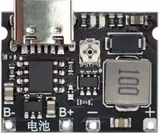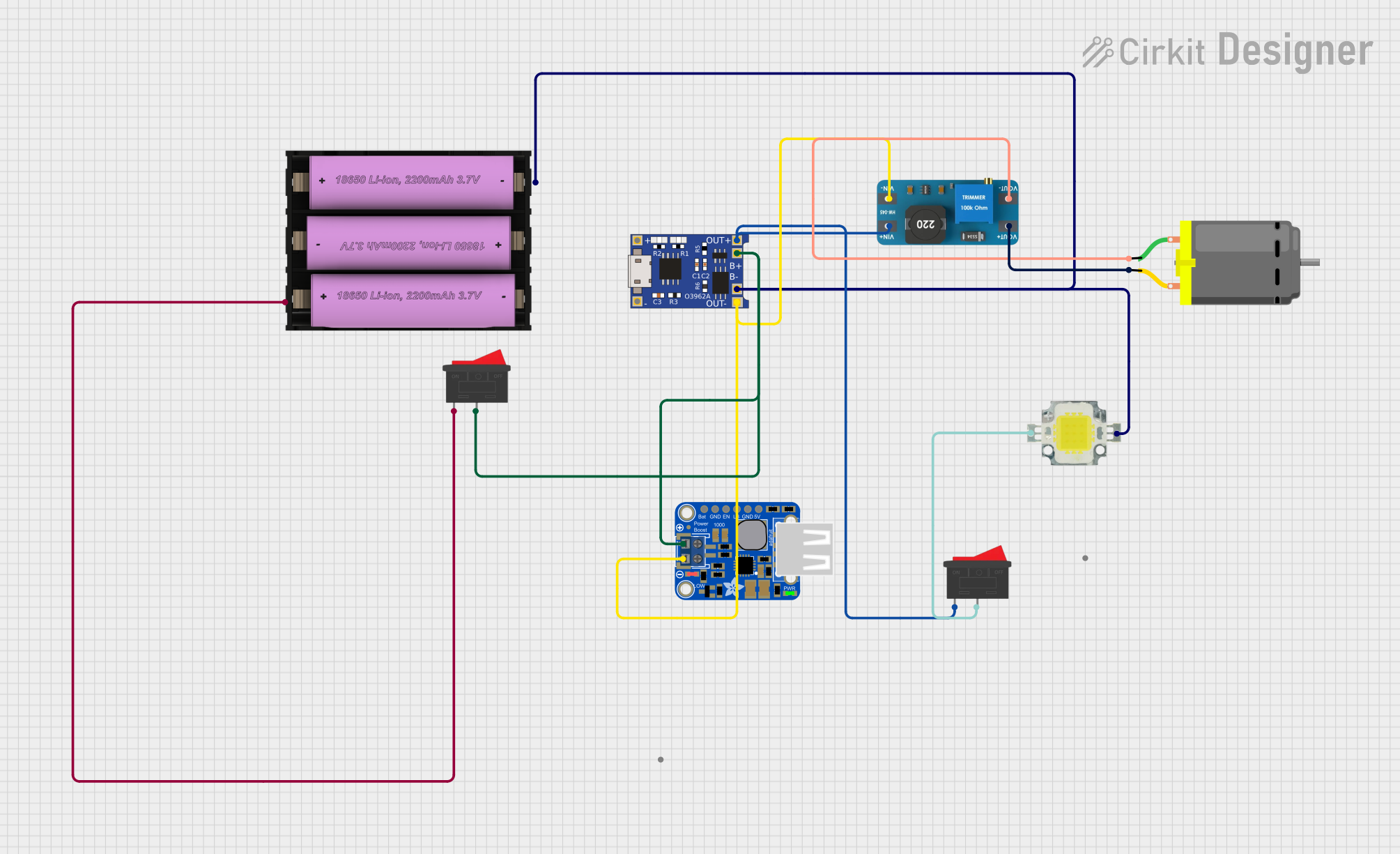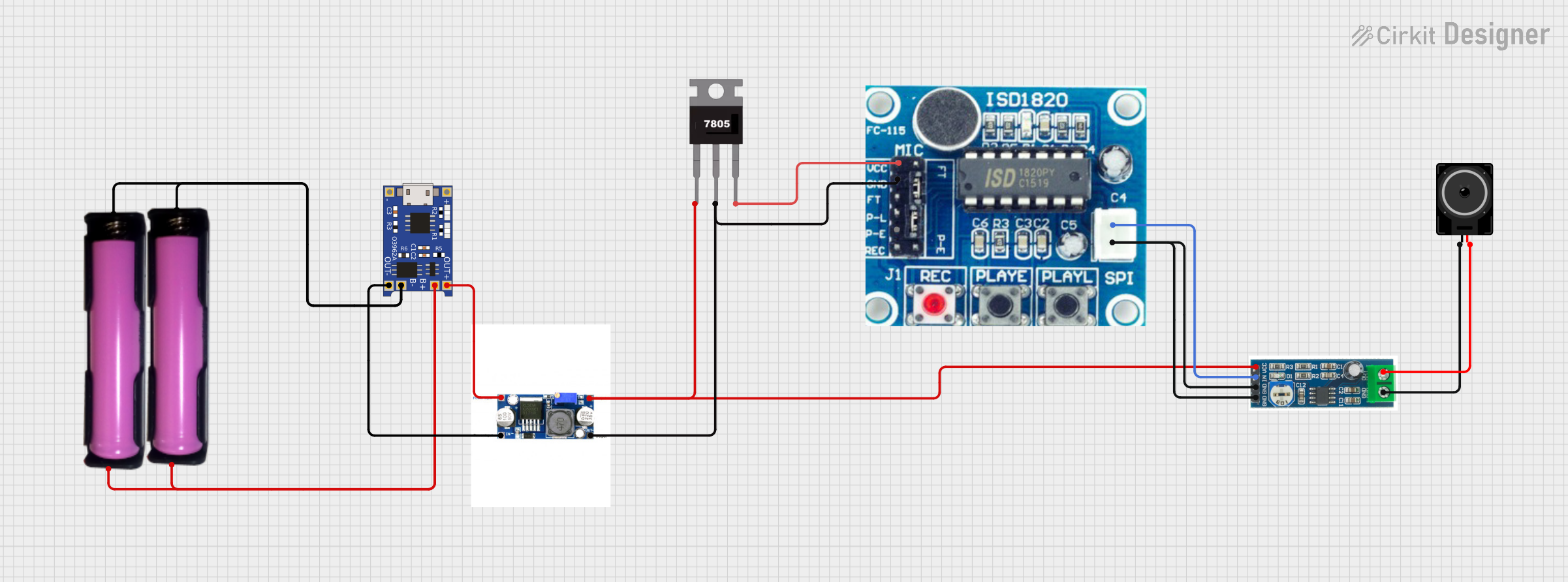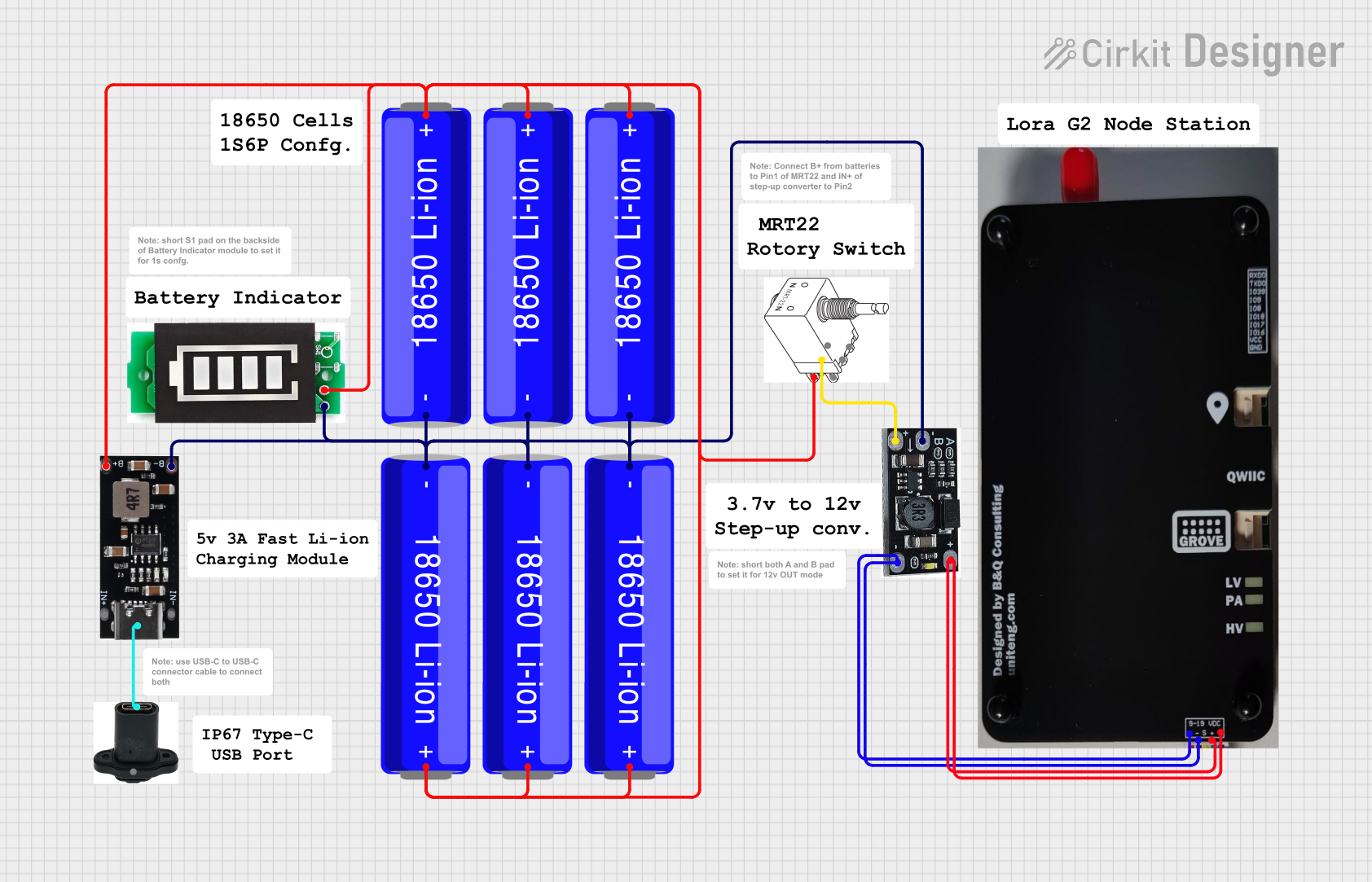
How to Use Lipo Charger and Boost Module: Examples, Pinouts, and Specs

 Design with Lipo Charger and Boost Module in Cirkit Designer
Design with Lipo Charger and Boost Module in Cirkit DesignerIntroduction
The Lipo Charger and Boost Module is a versatile electronic component designed to charge lithium polymer (LiPo) batteries and boost their output voltage to a higher, regulated level. This module is widely used in portable electronic devices where efficient power management is critical. It combines charging functionality with a step-up converter, making it ideal for applications requiring a stable voltage output from a single-cell LiPo battery.
Explore Projects Built with Lipo Charger and Boost Module

 Open Project in Cirkit Designer
Open Project in Cirkit Designer
 Open Project in Cirkit Designer
Open Project in Cirkit Designer
 Open Project in Cirkit Designer
Open Project in Cirkit Designer
 Open Project in Cirkit Designer
Open Project in Cirkit DesignerExplore Projects Built with Lipo Charger and Boost Module

 Open Project in Cirkit Designer
Open Project in Cirkit Designer
 Open Project in Cirkit Designer
Open Project in Cirkit Designer
 Open Project in Cirkit Designer
Open Project in Cirkit Designer
 Open Project in Cirkit Designer
Open Project in Cirkit DesignerCommon Applications and Use Cases
- Portable power banks
- Wearable devices
- IoT (Internet of Things) projects
- Arduino and microcontroller-based systems
- Battery-powered LED lighting
- Robotics and small motor-driven devices
Technical Specifications
Below are the key technical details of the Lipo Charger and Boost Module:
| Parameter | Value |
|---|---|
| Input Voltage Range | 2.5V to 5.5V |
| Output Voltage | 5V (regulated) |
| Output Current | Up to 1A |
| Charging Current | 500mA (default, adjustable in some models) |
| Battery Type Supported | Single-cell LiPo (3.7V nominal) |
| Efficiency (Boost Mode) | Up to 92% |
| Protection Features | Overcharge, over-discharge, short-circuit |
| Dimensions | Typically 22mm x 17mm x 4mm |
Pin Configuration and Descriptions
The module typically has the following pins:
| Pin Name | Description |
|---|---|
| BAT+ | Positive terminal for the LiPo battery connection |
| BAT- | Negative terminal for the LiPo battery connection |
| IN+ | Positive terminal for input voltage (e.g., USB or solar panel) |
| IN- | Negative terminal for input voltage |
| OUT+ | Positive terminal for boosted 5V output |
| OUT- | Negative terminal for boosted 5V output |
| CHG (optional) | Charging status indicator pin (low when charging, high when fully charged) |
Usage Instructions
How to Use the Component in a Circuit
- Connect the LiPo Battery:
- Attach the positive terminal of the battery to the
BAT+pin and the negative terminal to theBAT-pin.
- Attach the positive terminal of the battery to the
- Provide Input Power:
- Connect a power source (e.g., USB 5V or a solar panel) to the
IN+andIN-pins. Ensure the input voltage is within the specified range (2.5V to 5.5V).
- Connect a power source (e.g., USB 5V or a solar panel) to the
- Access the Boosted Output:
- Use the
OUT+andOUT-pins to power your load. The module will regulate the output to 5V.
- Use the
- Monitor Charging Status (if applicable):
- If the module has a
CHGpin, you can connect an LED or microcontroller to monitor the charging status.
- If the module has a
Important Considerations and Best Practices
- Battery Compatibility: Ensure the connected battery is a single-cell LiPo with a nominal voltage of 3.7V.
- Heat Management: The module may heat up during operation, especially at high currents. Ensure proper ventilation or heat dissipation.
- Avoid Overloading: Do not exceed the maximum output current (1A) to prevent damage to the module.
- Input Voltage: Ensure the input voltage does not exceed 5.5V to avoid damaging the module.
- Polarity: Double-check all connections for correct polarity to prevent short circuits or damage.
Example: Using with an Arduino UNO
The Lipo Charger and Boost Module can be used to power an Arduino UNO. Below is an example circuit and code:
Circuit:
- Connect the
OUT+pin of the module to the5Vpin of the Arduino UNO. - Connect the
OUT-pin of the module to theGNDpin of the Arduino UNO. - Connect a single-cell LiPo battery to the
BAT+andBAT-pins of the module.
Code:
// Example code to blink an LED using Arduino UNO powered by the Lipo Charger
// and Boost Module. Ensure the module is connected to the Arduino as described.
// Define the LED pin
const int ledPin = 13;
void setup() {
pinMode(ledPin, OUTPUT); // Set the LED pin as an output
}
void loop() {
digitalWrite(ledPin, HIGH); // Turn the LED on
delay(1000); // Wait for 1 second
digitalWrite(ledPin, LOW); // Turn the LED off
delay(1000); // Wait for 1 second
}
Troubleshooting and FAQs
Common Issues and Solutions
Module Not Powering On:
- Cause: Incorrect input voltage or loose connections.
- Solution: Verify that the input voltage is within the 2.5V to 5.5V range and check all connections.
Battery Not Charging:
- Cause: Faulty battery or incorrect polarity.
- Solution: Ensure the battery is functional and connected with the correct polarity.
Output Voltage Not 5V:
- Cause: Overloaded output or damaged module.
- Solution: Reduce the load to within the 1A limit. If the issue persists, replace the module.
Module Overheating:
- Cause: High current draw or poor ventilation.
- Solution: Reduce the load or improve heat dissipation by adding a heatsink or ensuring proper airflow.
FAQs
Q: Can I use this module with a 2-cell LiPo battery?
A: No, this module is designed for single-cell (3.7V nominal) LiPo batteries only.
Q: Can I adjust the output voltage?
A: Most modules have a fixed 5V output. If adjustable output is required, look for a module with a configurable boost converter.
Q: Is it safe to leave the battery connected to the module?
A: Yes, the module includes overcharge protection to prevent damage to the battery.
Q: Can I use this module to power a Raspberry Pi?
A: While the module can provide 5V, ensure the current draw of the Raspberry Pi (and peripherals) does not exceed 1A.
This concludes the documentation for the Lipo Charger and Boost Module.